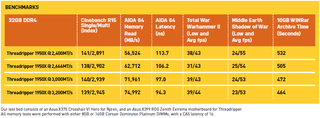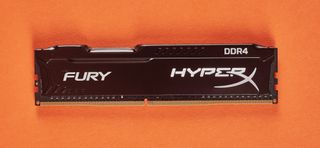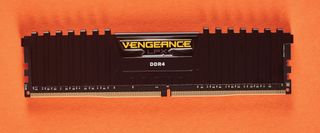What you need to know when you're upgrading your RAM
A fresh look at the state of DDR4 in 2018.
Memory and AMD platforms
Ryzen is an oddity when it comes to memory. For the first time in eons, memory speed impacts processor performance. Simply going from 2,133MT/s to 3,200MT/s can equate to a performance increase of around 10 percent in rendering tasks. Combine that with an overclock on your Ryzen CPU, and you can net yourself almost 25 percent more grunt. Why is this? It’s all down to how AMD has crafted its Infinity Fabric. This is the interface that connects all the core complexes in the processor together, enabling them to communicate with one another.
The Infinity Fabric is directly controlled by the IMC (integrated memory controller), so the higher the speed of the memory, the faster the IMC operates, and the quicker the processor can transfer bits of data across each core complex. It’s a smart solution, but it does mean that Ryzen is somewhat bound by its dependency on faster memory—not so good when the memory market is priced as high as it is today. So, best bet? If you’re heading toward Team Red’s Ryzen platform, get the highest frequency memory you can, at a capacity that best suits you.



Now we’ve wrapped up exactly how AMD benefits from memory speed in particular (thanks, Infinity Fabric), it’s time we got down to the nitty-gritty of recommending some kits and specs. As with the Intel recommendations, it’s worth noting that you don’t need to stick with the brands we’ve picked out below, because prices are fluctuating about rather haphazardly at this point. We’ve just tried to balance, price, spec, and performance to come up with the perfect pairings for your AMD-based build.

Office and home theater
4GB (1x4GB) @ 2,666MT/s, CAS 16 ($45–$60) Even if you're running one of the new Ryzen APUs, unless you're playing games you won't need a lot of fast memory. A single stick of 4GB DDR4 at 2,666MT/s fits the bill perfectly. Ryzen has always been a bit fussy with memory, so make sure you go for a mainstream brand here, check your motherboards approved list of modules, and stick with 2,666MT/s and above where you can.
If you do want to play some games on a Ryzen APU, however, grabbing a 2x4GB kit at a minimum is highly beneficial as the integrated GPU needs all the bandwidth it can get. (In testing, dropping from DDR4-3200 to DDR4-2400 reduced APU gaming performance by 20 percent, and using a single stick would further reduce performance.)
Gaming
16GB (2x8GB) @ 3,200MT/s, CAS 16 ($170–$210) That price jump is painful, but we reckon it’s worth it for this kit. For gaming, frame rates matter, and near-instantaneous communication between Ryzen’s intricate core complexes certainly helps batter those low frame rates into submission, at the very least. With a super-low latency of 10ns, a 3,200MT/s kit with a CAS latency of 16 will set you back a good $200, but it’s definitely the best way to game on Ryzen. Period.

Workstation
32GB (4x8GB) @ 3,000MT/s, CAS 15 ($350–$420) We’ve opted for more capacity here, but a slight drop in frequency in contrast with the gaming recommendation above. This is mostly centered around the notion that the gains from Threadripper’s memory speed increase (from 3,000 to 3,200) weren’t that impressive. That said, it’s still a kick-ass kit, and the latency combo is perfect, if you can get a kit at a good price. G.Skill’s Ripjaws V series is the best value we’ve seen so far.
PC Gamer Newsletter
Sign up to get the best content of the week, and great gaming deals, as picked by the editors.
This article was originally published in Maximum PC issue 149, and we've made minor formatting and content edits for the web. For more quality articles about all things PC hardware, you can subscribe to Maximum PC now.
Alan has been writing about PC tech since before 3D graphics cards existed, and still vividly recalls having to fight with MS-DOS just to get games to load. He fondly remembers the killer combo of a Matrox Millenium and 3dfx Voodoo, and seeing Lara Croft in 3D for the first time. He's very glad hardware has advanced as much as it has though, and is particularly happy when putting the latest M.2 NVMe SSDs, AMD processors, and laptops through their paces. He has a long-lasting Magic: The Gathering obsession but limits this to MTG Arena these days.
Most Popular



